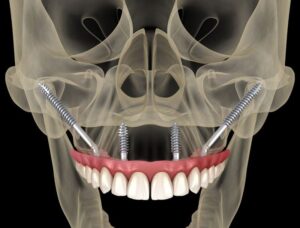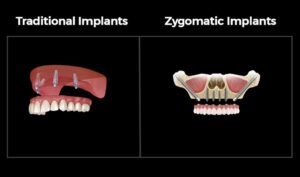Zygomatic Implants are an optimal solution for patients with severe upper jaw bone loss who are not eligible for conventional implants. If you are facing similar issues, don’t miss this informative article. Joy International Dental Clinic will help you gain a deeper understanding of this innovative implant method.
1. What are Zygomatic Implants?
Zygomatic Implants are a restorative dental procedure specifically designed for patients who have lost teeth in the upper jaw and suffer from significant bone loss, rendering them ineligible for traditional dental implants.
The key difference with Zygomatic Implants is that the implants are anchored directly into the zygomatic bone (cheekbone) rather than the jawbone. This provides increased stability and support for restoring the dental structure. This method is typically employed in cases of severe bone resorption or when traditional bone grafting techniques have been unsuccessful.
This procedure is recognized as one of the most challenging and complex surgical implant techniques. It requires highly skilled surgeons with extensive experience and access to advanced equipment to ensure a safe and successful outcome.

2. Advantages and Disadvantages of Zygomatic Implants
2.1 Outstanding Advantages of Zygomatic Implants
First and foremost, Zygomatic Implants can be considered an excellent solution for complex tooth loss cases, especially when the upper jawbone has experienced significant resorption or in cases where previous implant attempts have failed.
This method effectively addresses bone deficiency without the need for bone grafting, saving considerable time and effort. This is achieved by using implants anchored directly into the zygomatic bone – a region with a naturally strong and dense bone structure.
Furthermore, when performed correctly and successfully, this technique ensures high stability and long-term durability.
Moreover, the restoration time frame is significantly shortened, allowing patients to regain their confident smiles and comfortable chewing ability sooner.
With a high success rate, Zygomatic Implants are particularly suitable for individuals who have experienced failures with previous restorative methods.

2.2 Some Disadvantages of Zygomatic Implants
Despite offering numerous outstanding benefits, Zygomatic Implants also have some drawbacks that should be considered.
Firstly, this is a complex technique requiring highly skilled and experienced surgeons with specialized expertise. If not performed correctly, the risk of complications such as damage to surrounding structures or infection can occur.
Additionally, the cost of this method is typically higher compared to traditional restorative techniques due to the specialized materials and advanced technology involved.
Furthermore, the recovery period after surgery may be longer for some patients, especially those with weakened constitutions or underlying health conditions.
3. The Zygomatic Implant Procedure: A Step-by-Step Guide
Step 1: Consultation and Cone Beam CT Scan
In this initial stage, the surgeon will thoroughly examine the jawbone and zygomatic bone structure using advanced Cone Beam CT technology. This allows for precise assessment of bone quality and quantity, identification of optimal implant placement sites, and development of a detailed surgical plan. This step is crucial to ensure everything is prepared for the surgery.

Step 2: Implant Placement Surgery
Once all preparations are complete, you will be scheduled for the implant placement surgery. With the aid of advanced surgical techniques, the surgeon will precisely place the implants into the zygomatic bone, creating a stable foundation for the artificial teeth. The entire process will be conducted in a sterile environment to ensure absolute patient safety during the operation.
Step 3: Prosthetic Restoration (Placement of Artificial Teeth)
After a designated healing period, allowing the implants to integrate with the bone, you will be scheduled for follow-up appointments. The final step involves attaching the prosthetic teeth (crowns, bridges, or dentures) to the implants, completing the restoration process. This restores full chewing function and aesthetics to your smile. With modern materials and techniques, the prosthetic teeth are not only durable but also offer a natural appearance, making it difficult to distinguish them from natural teeth. You can rest assured when choosing this method.
4. Comparing Zygomatic Implants to Traditional Implants and Bone Grafting
Zygomatic implants differ significantly from traditional implants. Traditional implants are placed directly into the jawbone, requiring sufficient bone volume and density. When bone loss occurs, bone grafting is often necessary to create adequate support for the implants. This adds to the treatment time, cost, and complexity of the procedure.
Zygomatic implants, on the other hand, bypass the need for bone grafting by anchoring directly into the dense zygomatic bone. This makes them an ideal solution for patients with severe bone loss who are not candidates for traditional implants or who wish to avoid the additional surgery and recovery associated with bone grafting.

5. Who are Ideal Candidates for Zygomatic Implants?
Ideal candidates for Zygomatic Implants include:
- Patients with significant upper jaw bone loss due to tooth loss, periodontal disease, or other factors.
- Patients who have experienced failed traditional implant procedures.
- Patients who wish to avoid bone grafting procedures.
- Patients in good overall health who can undergo oral surgery.
6. Aftercare and Recovery
Following Zygomatic implant surgery, patients can expect some swelling, bruising, and discomfort, which can be managed with prescribed medication. It is important to follow the post-operative instructions provided by your surgeon carefully to ensure proper healing and prevent complications. Regular follow-up appointments will be scheduled to monitor the healing process and ensure the long-term success of the implants.
Conclusion
In conclusion, Zygomatic Implants are a groundbreaking solution for individuals facing severe upper jaw bone loss and are an excellent alternative when traditional implants are not feasible. This advanced technique offers a reliable and efficient way to restore oral function, aesthetics, and overall quality of life. Thank you for reading this article. If you have any further questions, please contact Joy International Dental Clinic’s hotline for more detailed information and to schedule an appointment. We are committed to providing you with world-class dental care and helping you achieve a healthy and beautiful smile.






